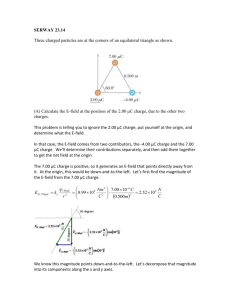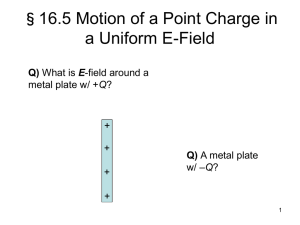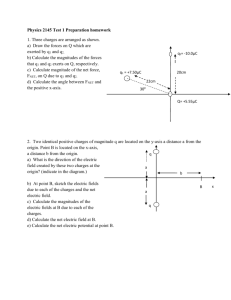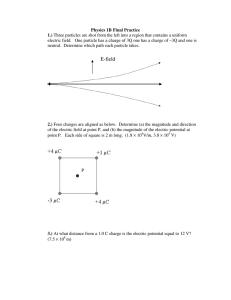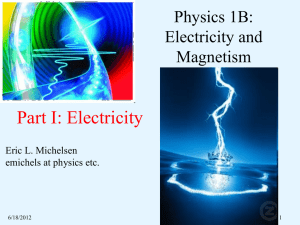RevExIans
advertisement
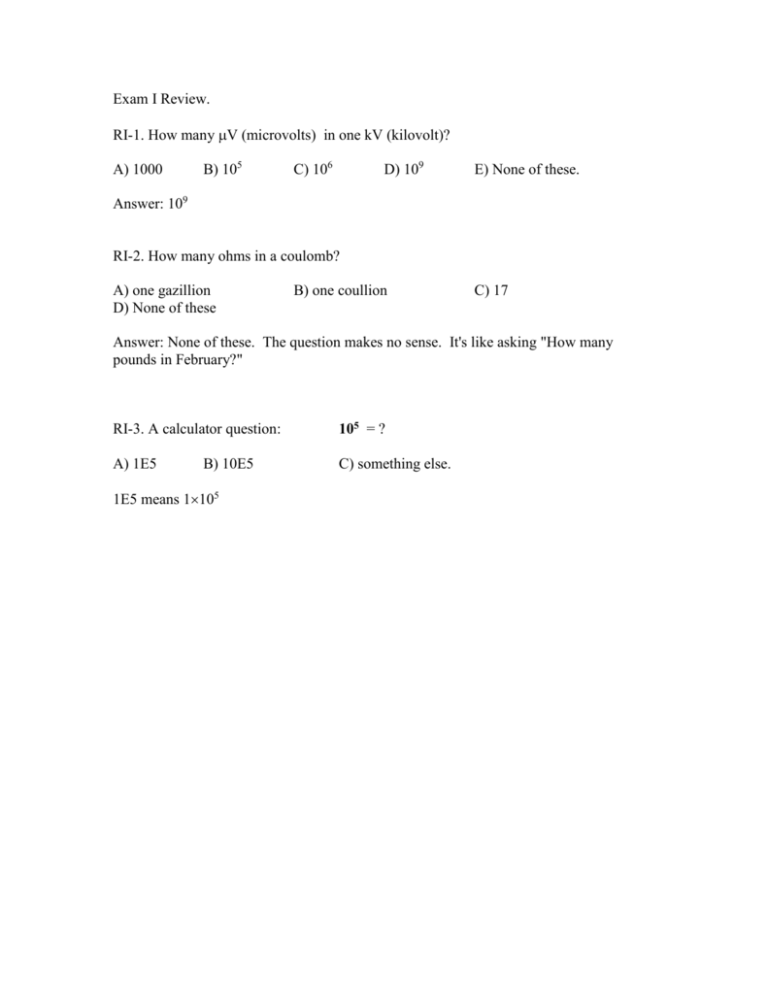
Exam I Review. RI-1. How many V (microvolts) in one kV (kilovolt)? A) 1000 B) 105 C) 106 D) 109 E) None of these. Answer: 109 RI-2. How many ohms in a coulomb? A) one gazillion D) None of these B) one coullion C) 17 Answer: None of these. The question makes no sense. It's like asking "How many pounds in February?" RI-3. A calculator question: 105 = ? A) 1E5 C) something else. B) 10E5 1E5 means 1105 RI-4. A box of mass m and net charge Q is on a frictionless plane inclined at angle . What is the magnitude of the electric force, F = QE, necessary to keep the box from sliding down the incline? m, +Q E A) Not enough info given to answer the question. B) mg C) mg /cos D) mg sin E) mg/ sin N QE Answer: mg sin RI-5. Does the magnitude of the normal force N depend on the magnitude of the E-field? A) Yes mg B) No Answer: No, the normal force is N = mg cos RI-6. Two pith balls, each of mass m, are suspended by light strings from the same pivot point. The two balls are each positively charged, so they repel. The left ball has a larger charge of +3Q, while the right ball has a smaller charge of +Q. Which figure most accurately shows the equilibrium positions of the charged pith balls? A uncharged +3Q B +Q C +3Q +Q +Q +3Q Answer: A By Newton's 3rd Law, each ball feels the same magnitude force. Since each has the same mass, the angle will be the same for both. RI-7. Three equal mass charges are released from rest at the positions shown on the xaxis. Which mass has the largest initial acceleration? +Q + A A) A B) B +Q + -Q - B C x C) C D) 2 of the masses have the same acceleration. E) Some other answer. Answer: B feels the largest size force, so it has the largest acceleration. RI-8. Four charges are arranged as shown, all a distance r from the origin. What is the direction of the E-field AT THE ORIGIN? y -Q r +Q x -4Q A C -Q D A) Up B) down E) None of these B C) upper right D) lower left Answer: None of these. The E-field at the origin points right. 9. What is the magnitude of the E-field at the origin, in units if kQ/r2 ? A) 2 B) 3 C) 4 D) None of these. Answer: None of these. the magnitude of the E-field is 5kQ/r2. RII-10. A point charge +q is brought from infinity to a point b near 3 other charges +Q, -Q, and +2Q. The charge q is brought along 3 different paths in turn, path 1, path 2, and path 3, as shown. Along which path is the most work done by the external agent carrying the charge +q? +2Q +Q Path 1 b Path 3 A) 1 B) 2 Path 2 -Q C) 3 D) Same work on all three paths Answer: Same work on all paths. W = PE = q V=q(Vb – V) = qVb. 11. Only the three charges +Q, -Q, and +2Q are present (q is absent) and the point b is midway between +Q and -Q. The voltage at point b is... A) positive B) negative C) zero Answer: Positive. RI-12. TRUE (A) or FALSE (B) ? If the voltage throughout a region of space is constant, the E-field throughout that region must be zero? Answer: True. |V| = E|| d. If V=0 between any two points throughout a volume of space, the E must be zero. RI-13. TRUE (A) or FALSE (B) ? If the E-field in a region of space is constant, the voltage throughout that region must be zero. Answer: False RII-14. Two equal and opposite charges +q and -q are a distance r apart or a distance 2 r apart. Which configuration (r or 2r) is the higher energy configuration? A) separation r is higher energy r B) separation 2r is higher energy +q +q -q 2r C) the energy is independent of separation/don't know -q Answer: separation 2r is higher (more positive) energy. For separation r, the PE = –kq2/r, for separation 2r, PE = -kq2/(2r). Although separation r has the higher magnitude PE, it is more negative. 15.A capacitor is attached to a battery which maintains a constant voltage V across the capacitor plates. While the battery is attached, the plates are moved further apart. The energy stored in the capacitor.. A) increased. B) decreased. V C) remained constant. Hint: U = (1/2)QV = (1/2)Q2/C = (1/2) CV2 Answer: U decreases! V is fixed! (by the battery). C decreases. So U = (1/2) CV2 decreases. This is a different from the case where Q is fixed. 16. A parallel-plate capacitor has square plates of edge length L, separated by a distance d. A second capacitor is made with L doubled and d decreased by a factor of 2. L L d By what factor is the capacitance of the new capacitor increased? A) 1 B) 2 C) 4 D) 16 E) None of these/don't know. Answer: C = A/d = L2/d. If L is doubled and d is halved, then C increases by 8. 17.Two capacitors, labeled 1 and 2 are identical is size and shape, except capacitor 2 has a dielectric between the plates, while 1 has air. The same charge Q is placed on both capacitors. Which has the higher voltage V? A) the air-core capacitor B) the dielectric capacitor C=Q/V. The one with the higher V will have the smaller C (since both have same Q). The air core capacitor has the smaller C, and the higher V.


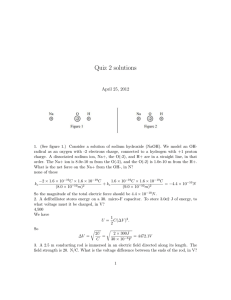
![Sample_hold[1]](http://s2.studylib.net/store/data/005360237_1-66a09447be9ffd6ace4f3f67c2fef5c7-300x300.png)




